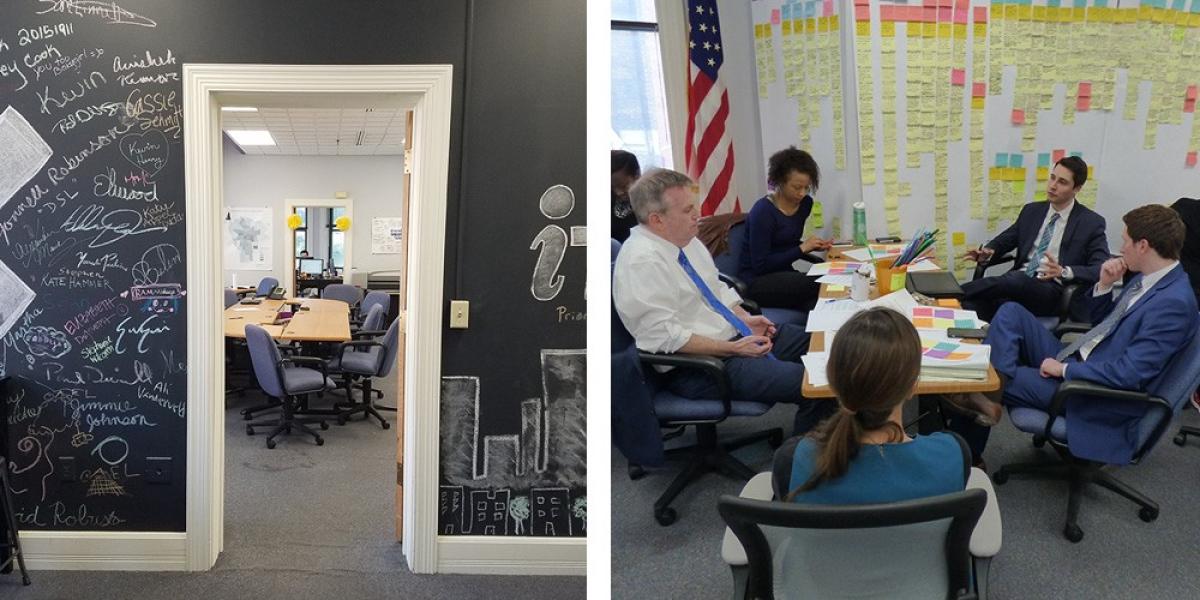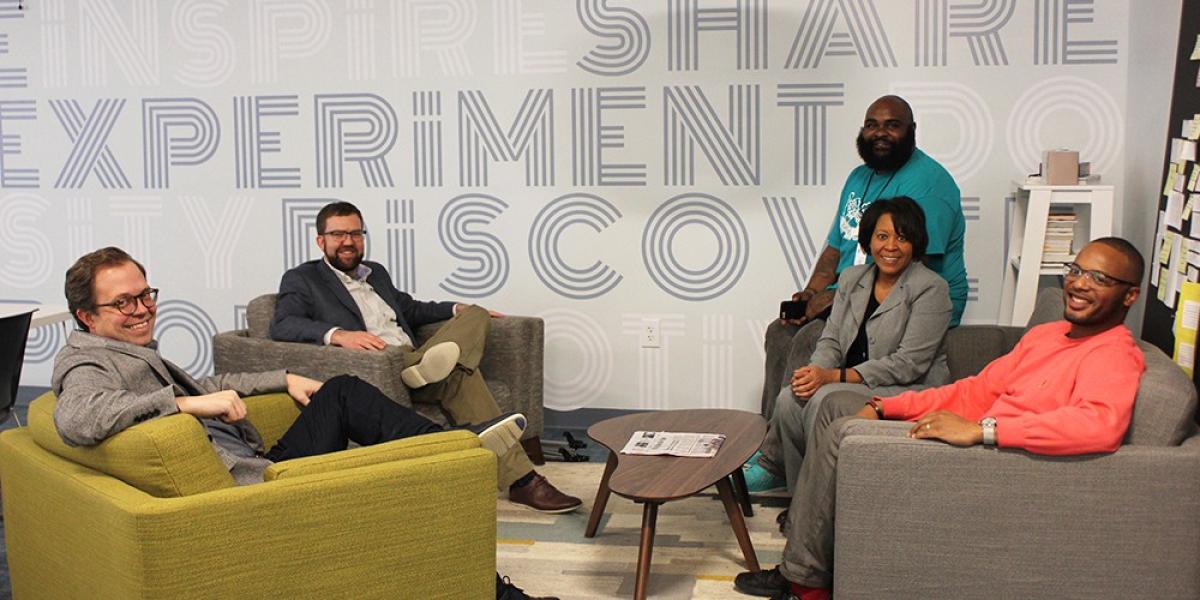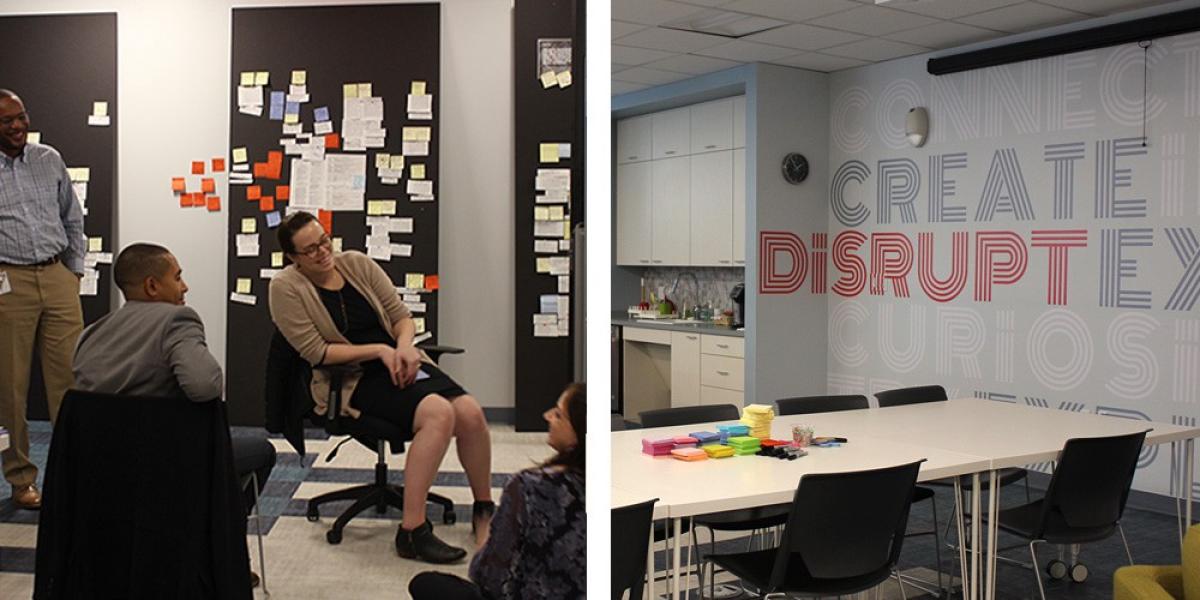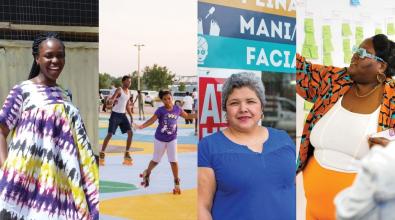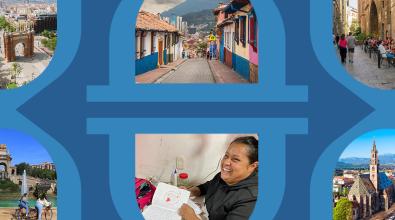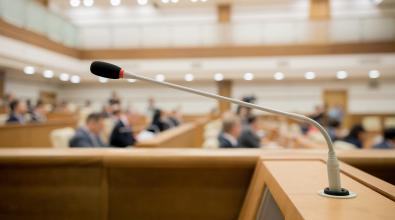How rethinking your workspace can spur innovation
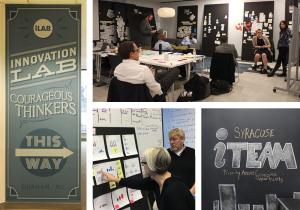
Disrupting “government as usual” can be tricky when you’re working from a standard-issue cubicle with stodgy white walls.
That’s why a number of the more than 20 Bloomberg Philanthropies-funded innovation teams around the world are rethinking their workspaces — as one of their steps to find new solutions to cities’ toughest challenges. Some of them worked with designers. Others have taken a more DIY approach. All of their new spaces share a few attributes:
- They ditch offices and cubicles for open spaces with movable furniture. This flexible working space both fosters collaboration among city hall employees and provides space for larger meetings to engage internal and external stakeholders as co-creators.
- They aim to invite people in, whether it’s other city employees or citizens, by using glass doors and walls, creative signage, or coffee and donuts. Engagement is the goal.
- The walls are painted bright colors — an intentional break from conservative off-whites common in many city halls — and are covered with oversized whiteboards, maps, charts and rainbows of sticky notes, all of which facilitate better idea creation.
Here’s what a few of the teams have learned in the process:
Syracuse, N.Y.: ‘We’re into Post-its’
The first thing you see when entering the Syracuse i-team’s office is a wall-sized chalkboard. The i-team’s priority issue area — promoting economic opportunity — is written in big letters, along with signatures of city employees, community leaders, and others who’ve visited. “We wanted people to feel excited about working with us,” said Adria Finch, the city’s director of innovation. Asking people to sign the wall was a fun way to encourage buy-in.
In their largest room, Finch replaced the giant conference table with a bunch of small tables that can be configured as needed — for both big and small meetings. She’s also stocked the room with LEGOs and pipe cleaners, which she says lead to productive fidgeting during meetings. “Having things for people to play with puts them at ease and gets the creative juices flowing,” she said. “Otherwise, people will play with their phones and you lose them. With the pipe cleaners, they pay attention.”
The team’s desks, which originally faced windows, now face each other and form a cluster. That makes collaborative conversations easier, Finch said, adding that she sneaks away to another room when she needs head-down, can’t-be-bothered quiet time.
There are Post-its everywhere. During workshops, ideas go into sticky notes that can be rearranged into common themes. “We’re into Post-its,” Finch acknowledged. But the most exciting part of the redesign was picking out paint colors; the team settled on blue with pops of orange and purple. “It was a good team bonding activity,” Finch said. “Paint isn’t expensive, but it’s been the biggest, short-term way to impact the culture here. People get so excited when they see a room that’s not what we call ‘city hall white.’”
Durham, N.C.: A former print shop becomes the ‘Innovation Lab’
Durham’s new Innovation Lab isn’t located in one of city hall’s high-traffic areas, which is why the big blue sign — with an arrow and the words “Courageous thinkers, this way” — helps. So, too, does the quote in the hallway from the late civil rights activist Pauli Murray: “What is often called exceptional ability is nothing more than persistent behavior.”
You’ll know you’ve arrived in the Durham i-team’s office when you see the words “impact,” “create,” “experiment,” “discover,” and “disrupt” painted on the wall. “The wall itself is disruptive, and affirmative,” said Jessica Kemp, who managed the design and construction of the project. “It’s creating a space where it’s OK to be disruptive.”
The lab, which occupies a space that used to be the city hall print shop, has a kitchenette in one corner and a cluster of workstations in another. Its core, however, is filled with sofas, tables, and chairs that are moved around as the conversation or collaboration requires — most often around the team’s primary mission: to improve economic opportunities for residents who have been involved in the criminal justice system.
[Read: Putting ex-offenders back in the driver’s seat in Durham]
“The work is very focused,” said Josh Edwards, the innovation team director. “We needed a big room to synthesize what we’re learning and interact with that information with residents.” Last week, for example, they welcomed a group of restaurant owners to learn more about their experiences hiring justice-involved residents.
“The point is to have space that inspires you to think differently and get out of what feels like a local government environment,” Edwards said. “We finally have a space in city hall that does that.”
Anchorage, Alaska: Hunting the $20 whiteboard
When the Anchorage i-team went looking for an office space last year, they got lucky: An airy ground-floor room with lots of light had just been vacated. The street-facing windows provided a unique kind of transparency for government work. Passersby can literally peek in from the street to see what the i-team is up to — and vice versa.
A few months ago, when the city altered its bus routes, the i-team had a nearly constant view of the changes at a nearby bus station. They invited bus drivers in to discuss how the change was working. “The fact that we’re on street level and have so many windows, it’s almost like we’re outside,” said Sioux-z Humphrey Marshall, the i-team program manager.
As in Durham and Syracuse, the space in Anchorage is a popular place for meetings — both for the team and with stakeholders throughout city hall and the city. The open layout has other benefits, as well — including the sense that any wall, pillar, or window can hold sticky notes, maps, or other information that might spark a creative idea. “When we’re trying to be creative in understanding a problem or situation, taking those observations and putting them up on stickies for everyone to look at together is a good way to get the ideas out of the spreadsheet on your laptop,” Marshall said.
Furnishings don’t have to be expensive, stressed Marshall, who plucked a tabletop out of a municipal trash area and matched it with a pair of sawhorses for legs. Her most prized find? White wall panels that she found at Lowes and turned into oversized whiteboards for about $20.“We really looked around to be creative about using existing things,” Marshall said. “And it’s working. That’s what we’re supposed to be doing in i-teams.”

